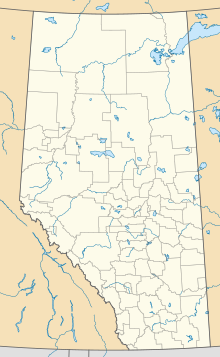Leslieville is a hamlet in Alberta, Canada within Clearwater County.[2] It is located east of Rocky Mountain House along the Canadian National Railway and has an elevation of 965 metres (3,166 ft).
Leslieville | |
|---|---|
Location of Leslieville in Alberta | |
| Coordinates: 52°23′00″N 114°36′17″W / 52.3833°N 114.6047°W | |
| Country | Canada |
| Province | Alberta |
| Census division | No. 9 |
| Municipal district | Clearwater County |
| Government | |
| • Type | Unincorporated |
| • Reeve | John Vandermeer |
| • Governing body | Clearwater County Council
|
| Area (2021)[1] | |
| • Land | 0.52 km2 (0.20 sq mi) |
| Elevation | 965 m (3,166 ft) |
| Population (2021)[1] | |
• Total | 134 |
| • Density | 257.9/km2 (668/sq mi) |
| Time zone | UTC−7 (MST) |
| • Summer (DST) | UTC−6 (MDT) |
The hamlet is located in Census Division No. 9 and in the federal riding of Wetaskiwin. It was first settled in 1903.[3]
Demographics
edit| Year | Pop. | ±% |
|---|---|---|
| 1941 | 113 | — |
| 1951 | 137 | +21.2% |
| 1956 | 152 | +10.9% |
| 1961 | 178 | +17.1% |
| 1966 | 172 | −3.4% |
| 1971 | 159 | −7.6% |
| 1976 | 132 | −17.0% |
| 1981 | 148 | +12.1% |
| 1986 | 168 | +13.5% |
| 1991 | 137 | −18.5% |
| 1991A | 143 | +4.4% |
| 1996 | 147 | +2.8% |
| 2001 | 206 | +40.1% |
| 2006 | 232 | +12.6% |
| 2011 | 239 | +3.0% |
| 2016 | 238 | −0.4% |
| 2016R | 151 | −36.6% |
| 2021 | 134 | −11.3% |
| Source: Statistics Canada [4][5][6][7][8][9][10][11][12][13][14][15][16][17][1] | ||
In the 2021 Census of Population conducted by Statistics Canada, Leslieville had a population of 134 living in 60 of its 64 total private dwellings, a change of -11.3% from its 2016 population of 151. With a land area of 0.52 km2 (0.20 sq mi), it had a population density of 257.7/km2 (667.4/sq mi) in 2021.[1]
As a designated place in the 2016 Census of Population conducted by Statistics Canada, Leslieville had a population of 238 living in 90 of its 96 total private dwellings, a change of -0.4% from its 2011 population of 239. With a land area of 2.26 km2 (0.87 sq mi), it had a population density of 105.3/km2 (272.8/sq mi) in 2016.[17]
See also
editReferences
edit- ^ a b c d "Population and dwelling counts: Canada and designated places". Statistics Canada. February 9, 2022. Retrieved February 10, 2022.
- ^ Alberta Municipal Affairs (April 1, 2010). "Specialized and Rural Municipalities and Their Communities" (PDF). Archived from the original (PDF) on February 29, 2012. Retrieved June 22, 2010.
- ^ Rocky Mountain House Reunion Historical Society (1977). Days Before Yesterday : History of Rocky Mountain House district. Rocky Mountain House: Rocky Mountain House Reunion Historical Society. p. 111. ISBN 0-88925-003-0.
- ^ Ninth Census of Canada, 1951 (PDF). Vol. SP-7 (Population: Unincorporated villages and hamlets). Dominion Bureau of Statistics. March 31, 1954. Retrieved September 22, 2024.
- ^ Census of Canada, 1956 (PDF). Vol. Population of unincorporated villages and settlements. Dominion Bureau of Statistics. October 25, 1957. Retrieved September 23, 2024.
- ^ 1961 Census of Canada: Population (PDF). Series SP: Unincorporated Villages. Vol. Bulletin SP—4. Ottawa: Dominion Bureau of Statistics. April 18, 1963. Retrieved September 25, 2024.
- ^ Census of Canada 1966: Population (PDF). Special Bulletin: Unincorporated Places. Vol. Bulletin S–3. Ottawa: Dominion Bureau of Statistics. 1968. Retrieved September 25, 2024.
- ^ 1971 Census of Canada: Population (PDF). Special Bulletin: Unincorporated Settlements. Vol. Bulletin SP—1. Ottawa: Statistics Canada. 1973. Retrieved September 25, 2024.
- ^ "Geographical Identification and Population for Unincorporated Places of 25 persons and over, 1971 and 1976". 1976 Census of Canada (PDF). Supplementary Bulletins: Geographic and Demographic (Population of Unincorporated Places—Canada). Vol. Bulletin 8SG.1. Ottawa: Statistics Canada. 1978. Retrieved September 26, 2024.
- ^ 1981 Census of Canada (PDF). Place name reference list. Vol. Western provinces and the Territories. Ottawa: Statistics Canada. 1983. Retrieved September 26, 2024.
- ^ 1986 Census of Canada (PDF). Population. Vol. Unincorporated Places. Ottawa: Statistics Canada. 1988. Retrieved September 26, 2024.
- ^ 91 Census (PDF). Population and Dwelling Counts. Vol. Unincorporated Places. Ottawa: Statistics Canada. 1993. Retrieved September 26, 2024.
- ^ 96 Census (PDF). A National Overivew: Population and Dwelling Counts. Ottawa: Statistics Canada. 1997. Retrieved September 26, 2024.
- ^ "Population and Dwelling Counts, for Canada, Provinces and Territories, and Census Divisions, 2001 and 1996 Censuses - 100% Data (Alberta)". Statistics Canada. August 15, 2012. Retrieved September 19, 2024.
- ^ "Population and dwelling counts, for Canada, provinces and territories, and designated places, 2006 and 2001 censuses - 100% data (Alberta)". Statistics Canada. July 20, 2021. Retrieved September 19, 2024.
- ^ "Population and dwelling counts, for Canada, provinces and territories, and designated places, 2011 and 2006 censuses (Alberta)". Statistics Canada. February 8, 2012. Retrieved September 19, 2024.
- ^ a b "Population and dwelling counts, for Canada, provinces and territories, and designated places, 2016 and 2011 censuses – 100% data (Alberta)". Statistics Canada. February 8, 2017. Retrieved February 13, 2017.
